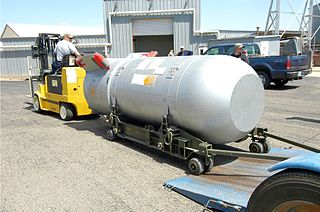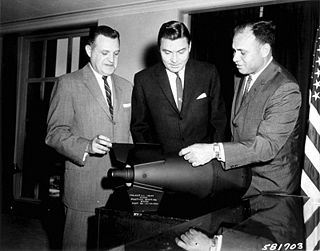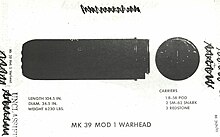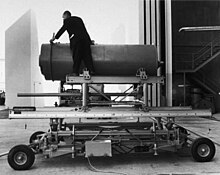
Yellow Sun was the first British operational high-yield strategic nuclear weapon warhead. The name refers only to the outer casing; the warhead was known as "Green Grass" in Yellow Sun Mk.1 and "Red Snow" in Yellow Sun Mk.2.

The W25 was a small nuclear warhead that was developed by the Los Alamos Scientific Laboratory for air-defense use. It was a fission device with a nominal yield of 1.7 kt.

The B61 nuclear bomb is the primary thermonuclear gravity bomb in the United States Enduring Stockpile following the end of the Cold War. It is a low-to-intermediate yield strategic and tactical nuclear weapon featuring a two-stage radiation implosion design.

The Mk/B53 was a high-yield bunker buster thermonuclear weapon developed by the United States during the Cold War. Deployed on Strategic Air Command bombers, the B53, with a yield of 9 megatons, was the most powerful weapon in the U.S. nuclear arsenal after the last B41 nuclear bombs were retired in 1976.

The B28, originally Mark 28, was a thermonuclear bomb carried by U.S. tactical fighter bombers, attack aircraft and bomber aircraft. From 1962 to 1972 under the NATO nuclear weapons sharing program, American B28s also equipped six Europe-based Canadian CF-104 squadrons known as the RCAF Nuclear Strike Force. It was also supplied for delivery by UK-based Royal Air Force Valiant and Canberra aircraft assigned to NATO under the command of SACEUR. In addition, certain U.S. Navy carrier based attack aircraft such as the A3D Skywarrior, A4D Skyhawk, and A3J Vigilante were equipped to carry the B28.

The B-41 was a thermonuclear weapon deployed by the United States Strategic Air Command in the early 1960s. It was the most powerful nuclear bomb ever developed by the United States, with a maximum yield of 25 megatons of TNT. A top secret document, states “The US has stockpiled bombs of 9 MT and 23 MT...” which would likely be referring to the B-41's actual yield(s). The B-41 was the only three-stage thermonuclear weapon fielded by the U.S.

Laydown delivery is a mode of delivery found in some nuclear gravity bombs: the bomb's descent to the target is slowed by parachute so that it lands on the ground without detonating. The bomb then detonates by timer some time later. Laydown delivery requires the weapon to be reinforced so that it can survive the force of impact.

The W54 was a tactical nuclear warhead developed by the United States in the late 1950s. The weapon is notable for being the smallest nuclear weapon in both weight and yield to have entered US service. It was a compact implosion device containing plutonium-239 as its fissile material, and in its various versions and mods it had a yield of 10 to 1,000 tons of TNT.

Mark 7 "Thor" was the First tactical fission bomb adopted by US armed forces. It was also the first weapon to be delivered using the toss method with the help of the low-altitude bombing system (LABS). The weapon was tested in Operation Buster-Jangle. To facilitate external carry by fighter-bomber aircraft, Mark 7 was fitted with retractable stabilizer fins. The Mark 7 warhead (W7) also formed the basis of the 30.5 inches (775 mm) BOAR rocket, the Mark 90 Betty nuclear depth charge, MGR-1 Honest John rocket, and MGM-5 Corporal ballistic missile. It was also supplied for delivery by Royal Air Force Canberra aircraft assigned to NATO in Germany under the command of SACEUR. This was done under the auspices of Project E, an agreement between the United States and the UK on the RAF carriage of US nuclear weapons. In UK use it was designated 1,650 lb. H.E. M.C. The Mark 7 was in service from 1952 to 1967(8) with 1700–1800 having been built.

The W50 was an American thermonuclear warhead deployed on the MGM-31 Pershing theater ballistic missile. Initially developed for the LIM-49 Nike Zeus anti-ballistic missile, this application was cancelled before deployment. The W50 was developed by Los Alamos National Laboratory. The W50 was manufactured from 1963 through 1965, with a total of 280 being produced. They were retired from service starting in 1973 with the last units retired in 1991.

The W87 is an American thermonuclear missile warhead formerly deployed on the LGM-118A Peacekeeper ("MX") ICBM. 50 MX missiles were built, each carrying up to 10 W87 warheads in multiple independently targetable reentry vehicles (MIRV), and were deployed from 1986 to 2005. Starting in 2007, 250 of the W87 warheads from retired Peacekeeper missiles were retrofitted onto much older Minuteman III missiles, with one warhead per missile.

The W84 is an American thermonuclear warhead initially designed for use on the BGM-109G Gryphon Ground Launched Cruise Missile (GLCM).

The W49 was an American thermonuclear warhead, used on the Thor, Atlas, Jupiter, and Titan I ballistic missile systems. W49 warheads were manufactured starting in 1958 and were in service until 1965, with a few warheads being retained until 1975.

The W58 was an American thermonuclear warhead used on the Polaris A-3 submarine-launched ballistic missile. Three W58 warheads were fitted as multiple warheads on each Polaris A-3 missile.

The W59 was an American thermonuclear warhead used on some Minuteman I ICBM missiles from 1962 to 1969, and planned to be used on the cancelled GAM-87 Skybolt air-launched ballistic missile.
The B61 Family is a series of nuclear weapons based on the B61 nuclear bomb.

The Mark 15 nuclear bomb, or Mk-15, was a 1950s American thermonuclear bomb, the first relatively lightweight thermonuclear bomb created by the United States.

On 14 March 1961 an aircraft accident occurred near Yuba City, California. A United States Air Force B-52F-70-BW Stratofortress bomber, AF Serial No. 57-0166, c/n 464155, carrying two nuclear weapons departed from Mather Air Force Base near Sacramento. According to the official Air Force report, the aircraft experienced an uncontrolled decompression that required it to descend to 10,000 feet (3,000 m) in order to lower the cabin altitude. Increased fuel consumption caused by having to fly at lower altitude, combined with the inability to rendezvous with a tanker in time caused the aircraft to run out of fuel. The aircrew ejected safely, and the now uncrewed aircraft crashed 15 miles (24 km) west of Yuba City, tearing the nuclear weapons from the aircraft on impact. The weapons did not detonate, as their safety devices worked properly. A fireman was killed and several others injured in a road accident while en route to the accident scene.

The 1961 Goldsboro B-52 crash was an accident that occurred near Goldsboro, North Carolina, United States, on 24 January 1961. A Boeing B-52 Stratofortress carrying two 3.8-megaton Mark 39 nuclear bombs broke up in mid-air, dropping its nuclear payload in the process. The pilot in command, Walter Scott Tulloch, ordered the crew to eject at 9,000 ft (2,700 m). Five crewmen successfully ejected or bailed out of the aircraft and landed safely; another ejected, but did not survive the landing, and two died in the crash. Information declassified since 2013 has shown that one of the bombs was judged by nuclear weapons engineers at the time to have been only one safety switch away from detonation, and that it was "credible" to imagine conditions under which it could have detonated.
























